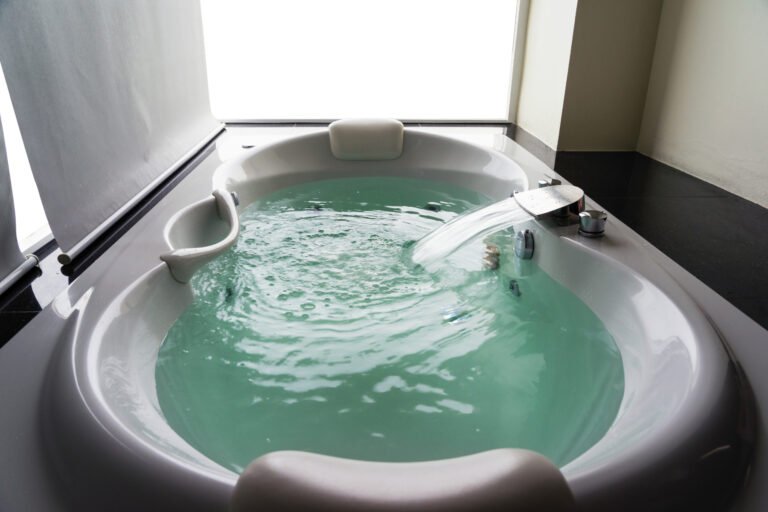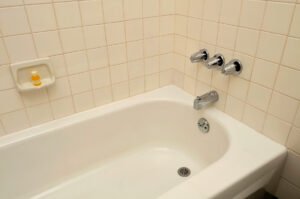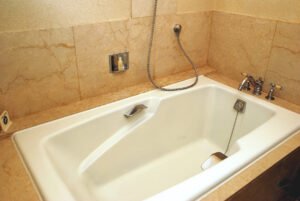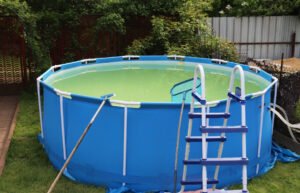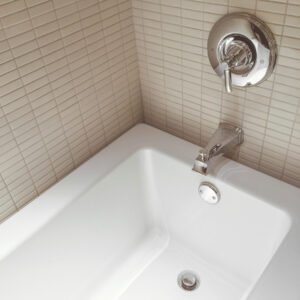Soiled, grubby, and filthy bathtubs are a nasty sight themselves. They not only multiply bacteria and germs but also have spots and stains that can adversely affect your skin. And regular cleaning agents like lime and dish soap will do little to discard those tough stains. So, how do you clean a bathtub perfectly?
One of the most effortless ways is to bleach them. But, since bleach is a caustic material, is it safe to use it for cleaning bathtubs? Or does bleach damage bathtubs? If yes, how do you use it without compromising your bathtub’s quality? Let’s analyze it all here.
Although bleach is a strong bathtub cleaner and disinfectant, it can damage or discolor the bathtub surface if used excessively or undiluted. Some bleaches, like chlorine and oxygen bleach, are more corrosive and do more damage than regular household or diluted bleach.
Which Bathtubs Can You Bleach?
Generally, smooth bathtub materials withstand the harshness of bleach and have a polished, protective layer that resists further abrasion. In contrast, textured and coarse bathtubs weather off easily with bleach. So, let’s explore the bathtub materials that look refurnished with bleaching.
1. Can You Bleach a Porcelain Bathtub?
You can bleach a porcelain bathtub but do not scrub it or wash it excessively, as the sensitive porcelain might chip off easily. Instead, cover your bath with paper towels and air-spray bleach using a spray bottle, and let it sit for about 30-45 minutes before removing the towels.
After that, rinse the bathtub with any non-abrasive cleaner and warm water and wipe it gently with a microfiber cloth to prevent any oxidation or discoloration.
Dilute oxygen bleach can be used in colored or textured porcelain bathtubs, while harsher chlorine bleach can be used in white porcelain bathtubs.
2. Can You Use Bleach on a Fiberglass Bath?
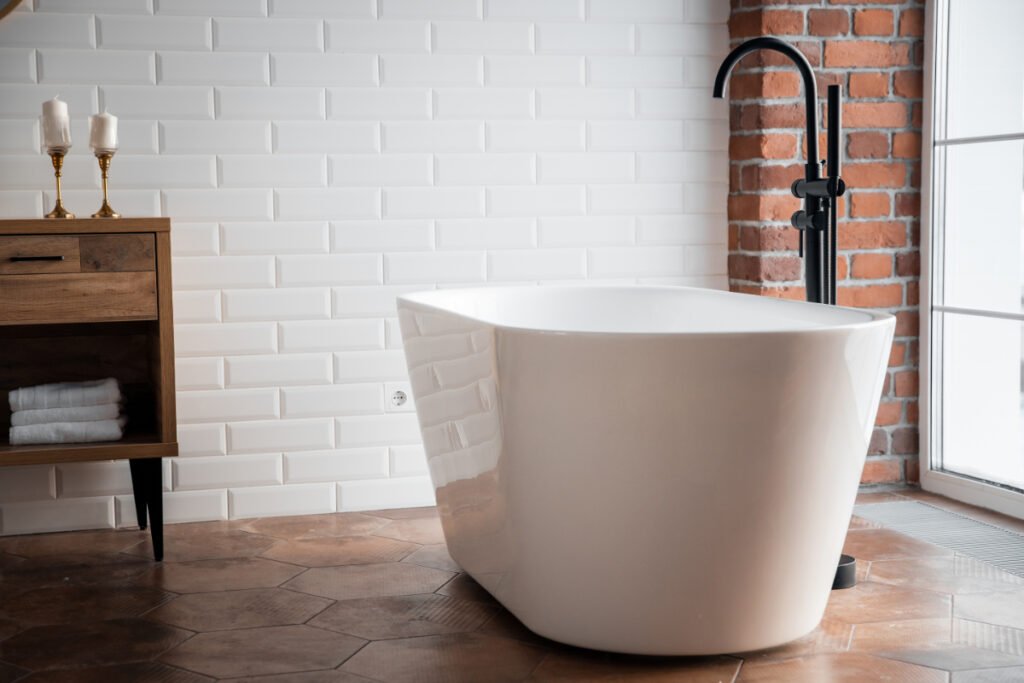
You can directly use bleach on a fiberglass tub, but since it’s slick and polished, you must evenly dab the bleach using a soft sponge and microfiber cloth. You can also spray it using a spray bottle, let it sit for 15 minutes, and then rub it off with a soft scrub and cold water.
Moreover, if you have an acrylic-enamel-finished tub, it’s advisable to dilute the bleach with equal water to prevent discoloration and weathering of the top coat.
Alternatively, mix about three parts of bleach and one part of water to remove the rust or hard water stains of your resin-coated fiberglass tub. Either way, avoid excessive scrubbing and scraping as it may damage the top glass coat and expose the bleach directly to the plastic underneath.
You can apply a thin layer of elbow grease to your fiberglass bathtub to keep its resin coat intact after bleaching.
3. Can You Bleach a Stone-Resin Tub?

You can clean a stone-resin tub with regular bleach instead of oxygen or chlorine bleach. First, rinse your bathtub with a diluted bleach solution of one part of household bleach and fifty parts of water, and then dab it using a microfiber cloth in circular motions.
Also, scrub it with any non-abrasive tile cleaner or toilet bowl cleaner to help hide the minor scratches and chips that might stand out more after bleaching.
Natural stones might discolor a bit on excessive and repetitive bleaching. Hence, you can coat them with a clear coat of polyurethane sealer to add more shine.
4. Can You Bleach a Plastic Bathtub?
Bleach can discolor and damage a colored plastic tub, but you can use it to disinfect and refurnish a white plastic bathtub. Spray a thin layer of diluted beach to cover the mild stains, raw household bleach for tougher stains, and harsher chlorine bleach to remove mildew and soap scum build-up in plastic baths.
Scrub a white plastic bathtub using bleach and a soft-bristled toothbrush for about 15 minutes to remove all the yellow stains and prevent mold.
5. Can You Use Bleach on a Cultured Marble Bathtub?
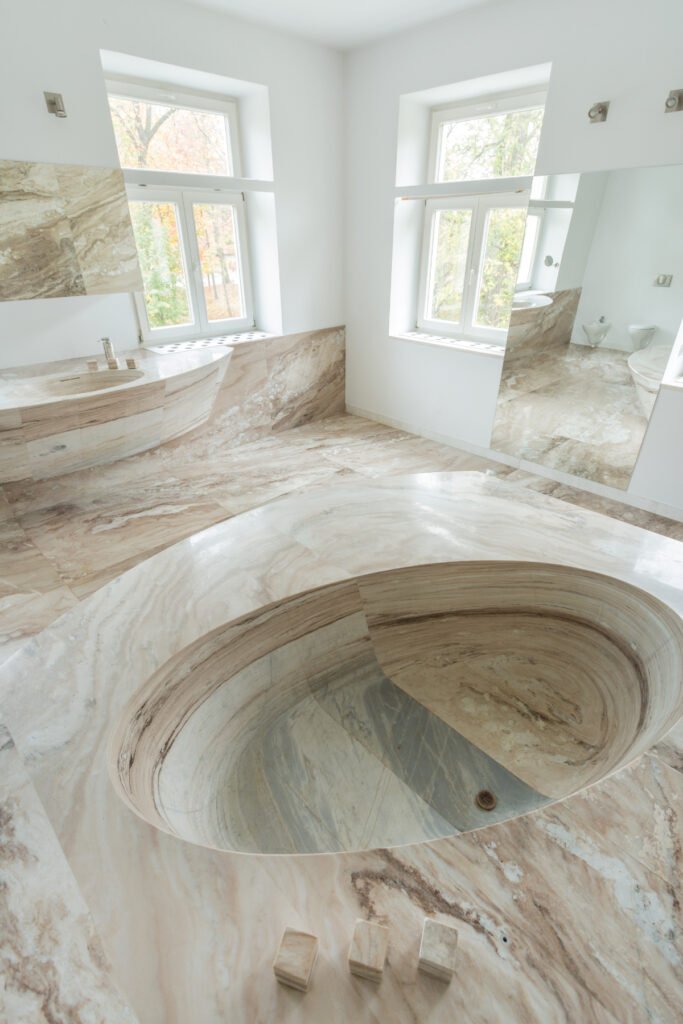
You cannot use corrosive chlorine or oxygen bleach on a marble bathtub, but a diluted bleach solution can be used to remove mild, yellow stains. Also, do not let the bleach sit on its surface for more than 15 minutes before rinsing it off with a non-abrasive bathtub cleaning agent and water.
Once bleached, apply wax, polish, or any sealer onto the marble surface after a minimum of 24 hours for a smooth finish.
Which Bathtubs Don’t Withstand Bleaching?
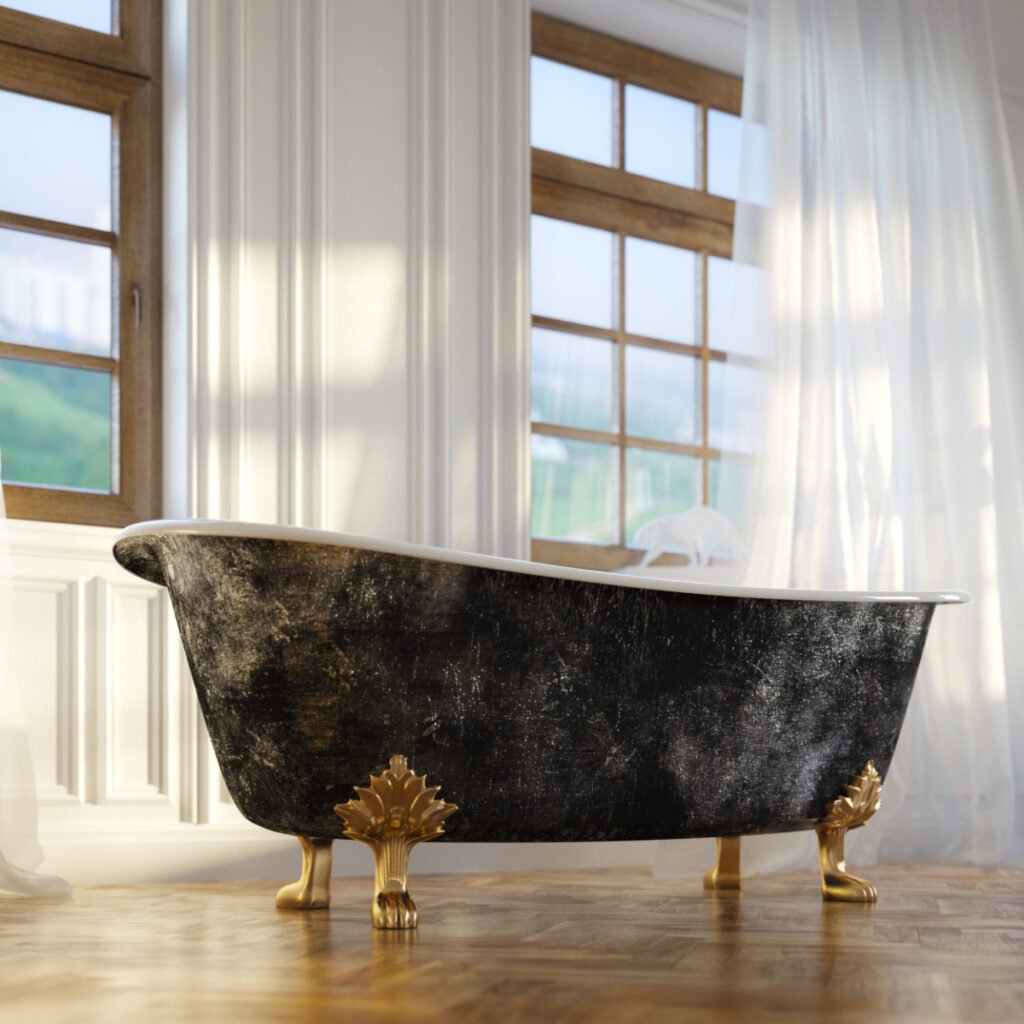
- Acrylic Bathtub: Bleach destroys the top finish of any acrylic tub and may add bumps, craters, or even holes to its surface. Plus, bleaching your acrylic tub may void its warranty, leaving you with permanent damage. However, you can use powdered oxygen bleach on acrylic as a disinfectant once a year.
- Cast Iron Tub: Bleaching cast iron tubs will leave you with red streaks and rust stains all along the surface of your tub, damaging the tub color permanently.
- Copper Bath: Bleach reacts with copper’s natural patina, stains, and discolors on its surface, making it look old and shineless.
- Wooden Bath: Bleach corrodes the surface of most popular bathtub woods, such as Teak, Cypress, Mulberry, and Cedar. It seeps in through the layers of the timber and tears the surface, making the tub unfit for use.
- Crystal Tub: Crystal tubs are transparent and porous. Thus, bleach percolates down to the bottom and adds a whitish bathtub stain that might look repulsive from the outside.
- Enamel Tub: Enamel tubs have a thin, resin-like finish that tears and melts with bleaching, adding holes and uneven finishes that are unfit for use.
How to Clean a Bathtub With Bleach?
Working with volatile bleach requires care and caution, or it might damage your skin and irritate your eyes. So, before you begin bleaching your bath, here are a few essential tips to keep in mind.
- Ventilate the room, open all the windows, and turn on the exhaust to eliminate all the poisonous fumes during bleaching. Additionally, wear a face mask for more protection.
- Wear rubber gloves to prevent direct skin contact with bleach, and use safety glasses to protect your eyes.
- Cover your tiles with paper or towels to prevent accidental bleach stains, and clean them with a tile cleaner once you finish bleaching.
Now that you’re ready, let’s see how to clean a bathtub effectively using bleach.
How to Clean a Standard Bathtub With Bleach
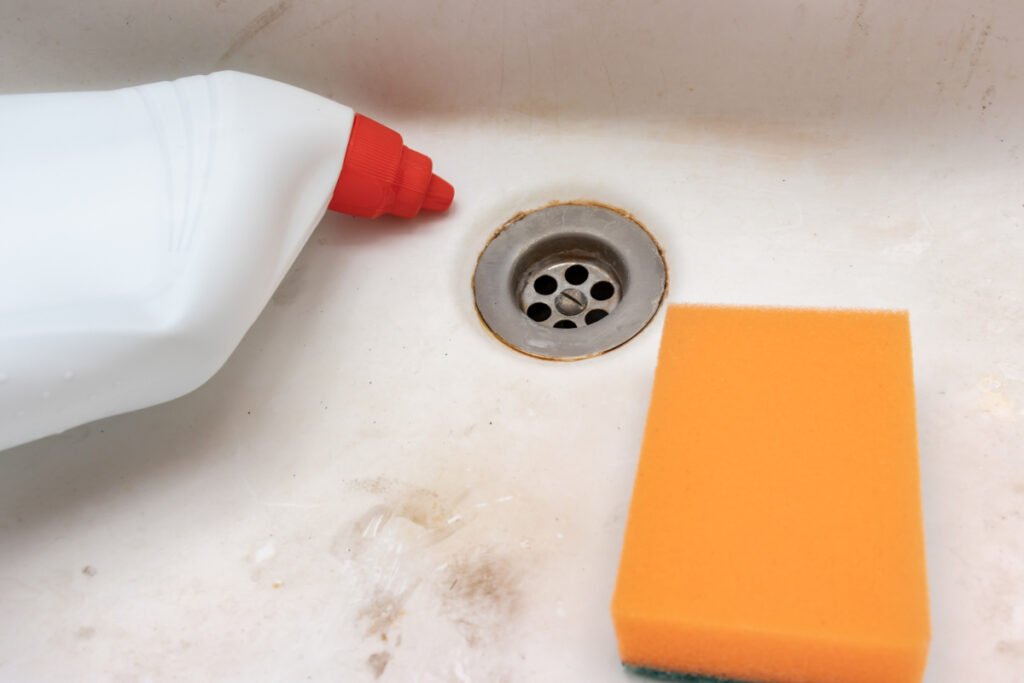
- Rinse the bathtub thoroughly and remove any soap scum or grease by scrubbing it with a soft sponge, dish soap, and clean water.
- Mix ½ cups of bleach in about 1 gallon of water, and gently spray this solution onto your tub using a spray gun. Let it sit for 15-20 minutes.
- Rinse the bathtub with any non-abrasive cleaner and wipe it off with a paper towel.
Mix a little bleach and baking soda and rub it in circular motions to remove any tough stains.
How to Clean a Jetted Tub With Bleach
- Fill a jetted tub with hot water up to the brim, and add about 1 cup of mild dish soap and 2 cups of powdered oxygen bleach.
- Run the jets for 20 minutes and drain the bathtub after that.
- Refill it with lukewarm water and run the jets for about half an hour to remove all the bleach residue.
- Wipe the tub with paper towels, and voila! You have a clean bathtub in no time.
Never use any commercial bathtub cleaner instead of mild dish soap, as it might form bubbles and damage the bathtub even more.
Advantages of Bleaching a Bathtub
- Disinfects the Surface: Bleach kills water bacteria, viruses, and amoebas present on the surface of your bathtub, prevents infections, and cleanses the surface.
- Removes Stains Effectively: Diluted bleach solution removes mild and hard water stains from your bathtub, whereas concentrated bleach powder removes tough stains and soap scum.
- Prevents the Yellowing of White Bathtubs: A bleach bath will remove all the yellow stains from your white bathtub and add extra shine to it.
- Unclogs a Choked Bathtub Drain: Concentrated bleach solutions loosen out the soap scum and other debris and clear any clogged bathtub drains. Moreover, bleaching baths dissolve the hair clogs in any bathtub trap and allow efficient drainage.
Disadvantages of Bleaching a Bathtub
- Emits Toxic Fumes: Bleach is highly reactive and emits harmful fumes when sprayed on a bathtub with traces of vinegar, drain cleaners, glass cleaners, or any products that contain ammonia. These fumes stain the surface of your bathtub and cause permanent damage.
- Needs Adequate Ventilation: Bleach is highly toxic when inhaled, and bleaching tubs in a poorly ventilated room can cause dizziness and other respiratory problems.
- Discoloration: Though bleaching reglazes white tubs, it discolors and stains any colored tubs and permanently damages their surface.
- Skin Irritant: Bleached bathtubs may irritate your skin and make it flaky and dry if you do not wash them thoroughly with water.
Tips for Bleaching Your Bathtub Safely
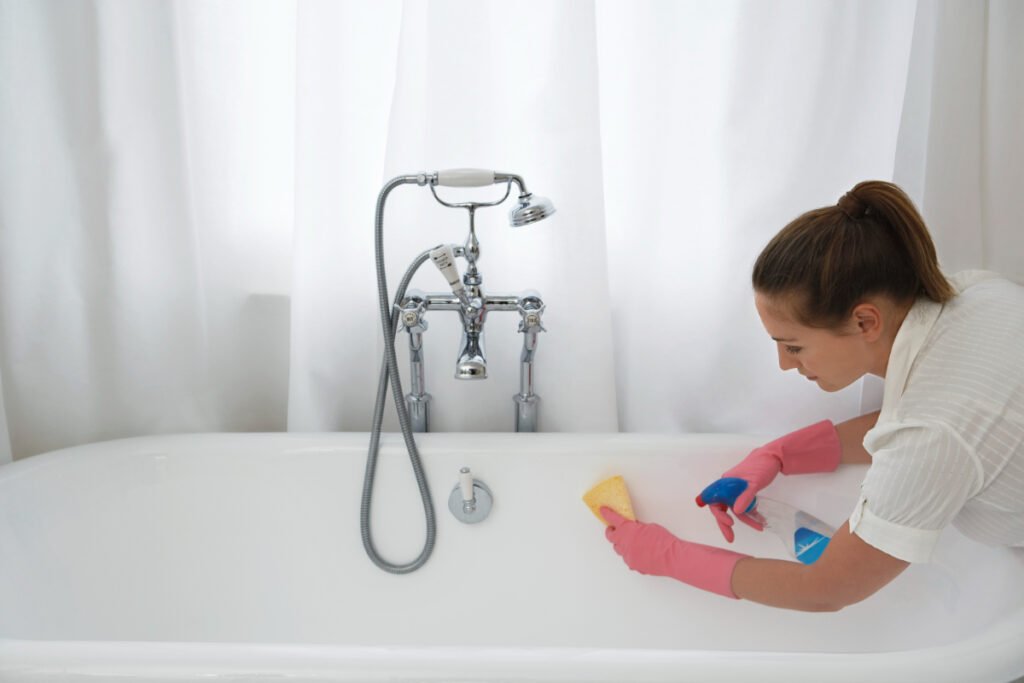
- Bathtub stains come out quickly and efficiently with a concentrated mixture of bleach and baking soda. However, it might damage porous stone, porcelain, and marble tubs.
- Move your shower curtains, mats, or any other fabric away from the bathtub before bleaching it, as it may discolor the materials and even burn them.
- Avoid bleaching a tiled bathtub, as bleach may destroy its color pigments and discolor them permanently.
- Use softer oxygen bleach powder to disinfect any colored bathtub grout and drain.
- Bleach can corrode the surface of any acrylic or enamel-coated tub when used in excess. So, always wash and scrub the tub thoroughly after bleaching.
- To remove mildew and mold, dip cotton balls in a diluted bleach solution and place them in hard-to-reach spots, such as the area around the caulk.
Alternatives for Bleach
Bleach is undoubtedly a powerful cleaner, but bleaching the bathtubs now and then can damage their surface and corrode them much faster. So, let us list some everyday cleaners and alternatives to bleach for mild stains.
- White Vinegar & Water: White vinegar removes a majority of mildew and hard water stains from white and colored bathtubs when diluted with equal water.
- Ammonia: A mixture of ammonia, vinegar, and baking soda removes moderate stains, yellowness, and mold accumulation from bathtub surfaces and refinishes your tub in no time.
- Washing Machine Detergents: You can mix any detergent with 1/4th cup baking soda to whiten soiled tubs and other grease stains.
- Borax: Spray a solution of ½ cup borax and two cups water over your bathtub to remove yellow stains and grease blotches.
- Hydrogen Peroxide: Spray a diluted solution of 3% hydrogen peroxide onto your bathtub’s surface and let it sit for about 15-20 minutes to clear away the molds, mildew, and fungi from the surface.
How to Disinfect a Bathtub Without Bleach?
You can use natural disinfectants like lime, tea tree oil, and castor oil, or scrub the tub with diluted hydrogen peroxide, vinegar, or baking soda to disinfect it quickly. Alternatively, you can just place the tub in the sunlight outside and watch the molds and mildew instantly disappear.
Does Bleach Unclog a Bathtub?
Bleach loosens the soap scum, hair debris, and other impurities from your bathtub drain and unclogs it in no time. To do so, pour some bleach powder into your bathtub drain, let it sit for 10 minutes, and wash off the area with hot water.
How Often Should You Bleach Your Bathtub?
Bleach your bathtub twice a month to prevent mold, mildew, and bacteria from accumulating on its surface. Alternatively, you can bleach it once a month to prevent discoloration, then clean it with vinegar once a week to avoid any tough stains and accumulation.
For How Long Can You Leave Bleach in Your Bathtub?
You can leave bleach in your tub for 10-15 minutes. However, bleach may discolor your bathtub if left more than that and can cause permanent damage to its surface.
How Long Should You Wait to Reuse the Tub After Bleaching?
It’s advisable not to use the tub the same day it is bleached, as any leftover bleach might damage your skin and irritate your eyes. However, you can use your bathtub the next day after giving it a proper rinse with soap and cold water.
Bleaching is an easy, effortless technique for disinfecting bathtubs and removing their tough stains. Of course, overusing bleach does damage the surface of any bathtub, but diluted bleach won’t do any harm. It’ll smoothly remove stains, grease, molds, and mildew, giving you a refinished tub.
But, if excessive use of bleach has already discolored your bathtub, you should consider painting it for a quick revamp. But can you paint a bathtub? If yes, what type of paint and paint finish do you use? Join us to know it all.

